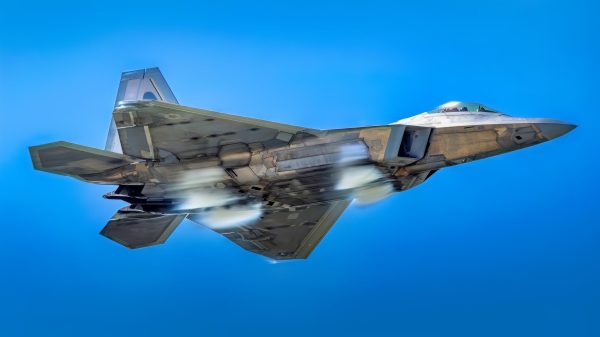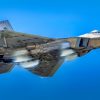Key Points and Summary – NASA’s X-43A proved an audacious idea: use a scramjet—a jet that breathes air at supersonic speeds—to fly near Mach 10.
-Dropped from a B-52 and boosted by a Pegasus rocket to test speed and altitude, the 12-foot research vehicle ignited its hydrogen-fueled scramjet for seconds that made history: Mach 6.8 in March 2004 and Mach 9.6 that November.
-The three-flight Hyper-X program ended after meeting its core goals, as funding and priorities shifted.
-Though short-lived, X-43A’s flight data, materials lessons, and control strategies became the starting point for later U.S. hypersonic efforts—and the benchmark for air-breathing speed.
X-43A: NASA’s Mach 9.6 Hypersonic Proof-Of-Concept
By the late 1990s, engineers had squeezed about all they could from wind tunnels and simulations of scramjets (supersonic-combustion ramjets).
The catch: scramjets only make sense at hypersonic speed, where air rushing through the inlet stays supersonic as it mixes with fuel and burns.
To know if scramjets truly work, someone had to fly one—close the loop on inlets, ignition, combustion stability, and controls in the real, high-temperature, high-pressure environment where models get shaky.
That was the point of Hyper-X: a modest, high-risk program built to turn decades of lab work into seconds of flight data that textbooks couldn’t provide.
The Concept: Small Vehicle, Big Questions
NASA kept the airframe tiny—about 12 feet long—to simplify logistics and focus on the engine. The X-43A would not take off on its own. Instead, a B-52 would air-drop a modified Pegasus rocket booster with the X-43A riding on its nose.
The booster would sprint the stack to the target speed and altitude; then the research vehicle would separate, open its inlet, and run its hydrogen-fueled scramjet for a short, carefully planned burn. After that, it would glide unpowered into the Pacific. Every second mattered.
The goal wasn’t endurance; it was to prove air-breathing propulsion beyond the lab.
The Path To Success Wasn’t Straight
The first flight attempt (2001) ended in failure when the booster went out of control and the range terminated the mission. That painful lesson forced two years of fixes—better modeling, cleaner controls, and a tighter booster/vehicle integration plan.
When Hyper-X returned to the air in 2004, the approach was the same but the engineering was wiser. What followed were two record flights that validated the entire idea of air-breathing hypersonics.
How X-43A Reached Mach 6.8—And Then Mach 9.6
Think of the profile as a relay:
Carrier Phase: A B-52B hauls the stack to altitude off California’s coast.
Boost Phase: The Pegasus first stage lights, pushing the stack up to the test window—tens of miles high and already at hypersonic speed.
Separation: The X-43A breaks free, stabilizes, and opens its inlet—the moment of truth.
Scramjet Burn: With hydrogen flowing, supersonic air rushes through the engine, combusts, and produces forward thrust. There are no compressors or turbines—just geometry, pressure, fuel, flame, and timing.
Data Harvest: Sensors soak up temperatures, pressures, thrust, and control behavior before the vehicle glides to a planned splashdown.
On March 27, 2004, the engine lit cleanly and sustained a burn around 11 seconds near Mach 6.8. On November 16, 2004, the third vehicle repeated the feat in a hotter regime, peaking near Mach 9.6—the fastest air-breathing flight on record. The burn lasted mere seconds, but at those speeds seconds are a lifetime of data.
What Those Few Seconds Proved
Combustion Stability: Supersonic flow can carry flame downstream before it releases useful energy; X-43A showed that you can ignite and sustain high-Mach combustion in flight.
Integrated Aeropropulsion: Airframe, inlet, and nozzle must behave as one system. X-43A’s results validated airframe-integrated scramjet design assumptions that tunnels could only approximate.
Controls At The Edge: Even brief burns demanded exquisite attitude control so the engine saw the right airflow; the vehicle’s guidance and control laws delivered.
Materials And Heat: Temperatures soared. The team learned where coatings, thermal protection, and structures meet their limits—and how to design around them.
Why The X-43A Program Ended
Hyper-X was always scoped as a three-flight effort: one attempt at Mach ~7 (which failed and drove redesign), then Mach ~7 and Mach ~10 targets once the stack worked. After the 2004 successes, NASA had the data it asked for. Meanwhile, national priorities and budgets shifted.
Post-2004, funding emphasized other aerospace goals, and the Air Force took the lead on follow-on air-breathing hypersonics (eventually fielding the X-51A demonstrator years later). In short: X-43A wasn’t “canceled mid-stream” so much as concluded after meeting its narrow objectives, with resources redirected to the next phase under different sponsors.
Why Mach 9.6 Still Matters
Breaking Mach 9.6 with an air-breathing engine wasn’t just a speed stunt. It confirmed that scramjets can operate where rockets once had the field to themselves. That matters for any future system that wants high-speed, high-altitude flight without carrying oxidizer: rapid-response strike, long-range ISR, or even stages of access-to-space concepts. The X-43A also set a benchmark: it’s one thing to model hypersonics; it’s another to fly it and bring home the data.
Limits, Myths, And What X-43A Wasn’t
The X-43A was not a prototype airliner or a practical weapon. It didn’t take off by itself, didn’t land, and didn’t “cruise” for minutes at Mach 9+. It was a surgical experiment—prove the engine physics, validate the integration, and retire risk.
Turning that into an operational vehicle requires endurance, thermal management, reusable structures, large-envelope controls, and sustainable fuel systems—the hard, unglamorous work that follows any X-plane triumph.
The Legacy In Today’s Hypersonics
Look at modern U.S. hypersonic efforts and you’ll find X-43A’s fingerprints everywhere:
Engine/Vehicle Co-Design: Hyper-X hardened the habit of designing inlet, isolator, combustor, and nozzle with the airframe from day one.
Flight-First Mindset: Programs now aim early at flight-relevant conditions, not just tunnels, to spot the surprises that only real air uncovers.
Data As A Force Multiplier: The X-43A data set still anchors validation of codes and digital twins used to design next-generation vehicles.
Final Take on X-43A
The X-43A was a tiny machine with an oversized impact. In three flights—two that counted—it moved scramjets from theory to flight-proven reality, set an air-breathing speed record, and handed the baton to follow-on programs with a map of what works and what breaks.
That’s exactly what the best X-planes do: answer the decisive question, then get out of the way so the next generation can build on the answer.
About the Author: Harry J. Kazianis
Harry J. Kazianis (@Grecianformula) is Editor-In-Chief and President of National Security Journal. He was the former Senior Director of National Security Affairs at the Center for the National Interest (CFTNI), a foreign policy think tank founded by Richard Nixon based in Washington, DC. Harry has over a decade of experience in think tanks and national security publishing. His ideas have been published in the NY Times, The Washington Post, The Wall Street Journal, CNN, and many other outlets worldwide. He has held positions at CSIS, the Heritage Foundation, the University of Nottingham, and several other institutions related to national security research and studies. He is the former Executive Editor of the National Interest and the Diplomat. He holds a Master’s degree focusing on international affairs from Harvard University.
More Military
B-1B Lancer: The Bomber The Air Force Needs to Keep Flying
Su-37 ‘Terminator’: The Thrust-Vectoring Super Flanker Fighter That Never Was
Russia or China Would Love to Have the Aircraft Carrier USS Harry S. Truman
NATO’s Big Fear: Putin Drops a Tactical Nuclear Weapon on Ukraine
The U.S. Military’s Big F-22 Raptor Stealth Fighter Mistake Cuts Deep











Joseph K
September 25, 2025 at 12:07 pm
They should ask to borrow China’s wind tunnels. They’re the largest and most powerful in the world.
Space_Ranger
September 25, 2025 at 4:25 pm
They already said that wind tunnels can’t provide the data that real air can uncover so China can’t help at all with the x data that they got.
Paully
September 26, 2025 at 7:54 am
Thunderbird 1..
Krystal cane
October 27, 2025 at 7:00 pm
If they really need a wind tunnel to test an aircraft at that speed all they need to aim Trump’s rectum right into a pipe and get those speeds when he farts he’s so full of gases 😂
angelo corbin
October 31, 2025 at 8:12 pm
We have achieved this great speed over 20+ years and demo a plane that flew mach 20 with being launched from a plane, it is a hybrid of a aerospike engine and scramjet, but people think china has greater, they are decades behind us. Just like the peguesus rocket they use to launch the NASA X plane been out for over 30+ years and it is hypersonic, I know I seen it, I served in the Air Force
Htos1av
November 2, 2025 at 9:51 am
Cool, and all that, yes, my Dad flew the “U” series craft out of Honolulu….but WHEN are we goiung to use hydrogen for cars power stations and heating?
NO arguing, WHEN? If an “official” even PEEPS about ANYTHING OTHER than succeeding on this, chute it.
It’s TIME to REMOVE “power” from the tower of babylon known as “gov’t”, we DO IT VIA “power and money”.
That is all.
DocHollywood
November 5, 2025 at 8:06 pm
Kind of disappointing to turn on a video supposedly showing a hypersonic fighter and see a model too small to put a human on lashed to a rocket, shot from a plane, and then, when it separates, the video switches to a cartoon.